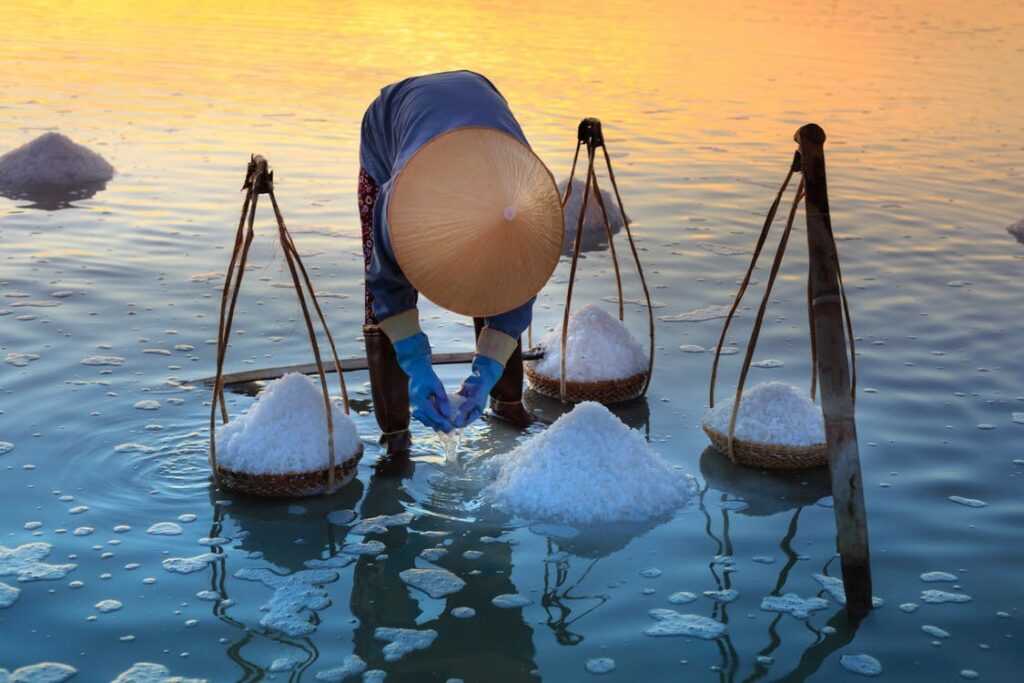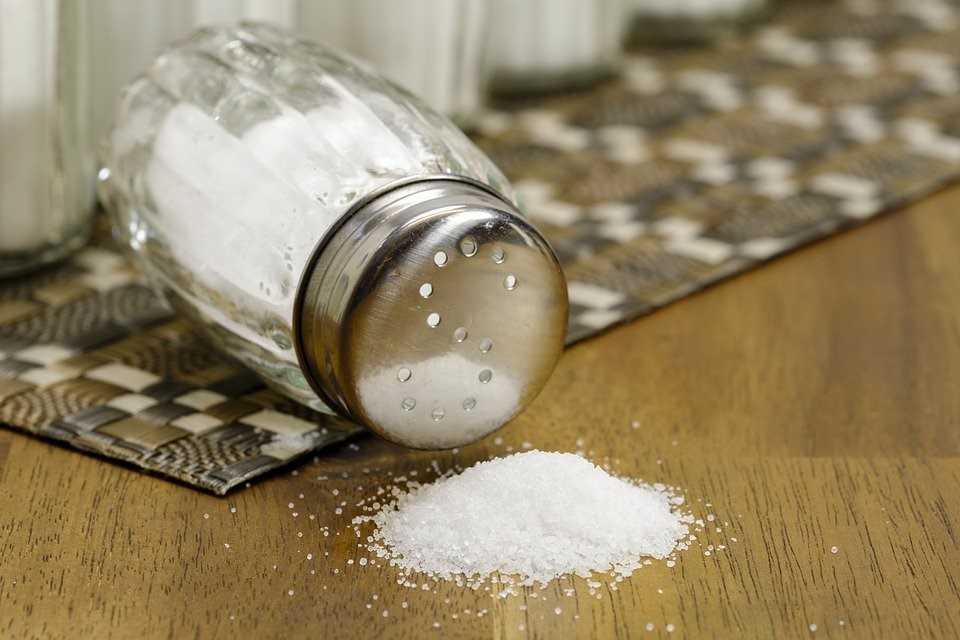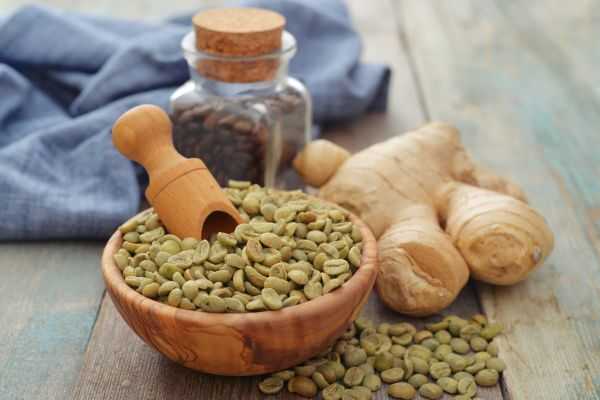Common edible salt, composed of sodium chloride NaCl (table salt), is the combination of the cation (Na+) and anion (Cl-). Salt is found naturally in seawater, in mineral deposits and in natural bodies of water (lakes, streams). Salt can be mined from underground deposits, either by rock salt mining or vacuum evaporation. It can be evaporated from seawater (sea salt) or other bodies of water.

Two of the most prevalent ions in seawater are chloride and sodium. Together, they make up over 90% of all dissolved ions in the ocean. Human body contains about 250gms of salt (3 or 4 full salt shakers). Salt comprises 40% sodium and 60% chloride.
Salt has been divided primarily into 4 basic types i.e. table salt, sea salt, kosher salt and rock salt. The first three types are food grade salt which as per FDA should contain at least 97.5% Nacl and 2.5% trace minerals:
- Table salt – it is refined salt with about 97-99% Nacl. To make it free flowing anti-caking agents like magnesium carbonate is added. Number of additives can be added to table salt to address various health problems.
E.g. iodine when added to salt it is called iodized salt which is used to cure thyroid gland dysfunction called goitre. Deficiency of iodine especially in children leads to a lowered production of thyroxin hormone from the thyroid gland called as hypothyroidism. To get sufficient iodine, thyroid gland starts increasing in size called as goitre. Iodine deficiency can also lead to mental retardation.
When iron is added along with iodine to salt, it is called double fortified salt for treating iron deficiency anaemia. Sometimes folic acid is also added to salt, which is especially beneficial for pregnant women to prevent neural tube defects and anaemia.
2. Sea salt – is made by evaporating sea water & is not as heavily processed as table salt and is generally costlier than table salt due to the extraction process. It contains trace minerals like calcium, magnesium, copper, iron, potassium, sulphur etc. which are generally removed during the refining process in table salt. It can be of different textures like fine or coarse and of the colour like pink, black, grey etc. It has a unique earthy flavour which is easily distinguishable.
In India black salt (kala namak) (a type of sea salt) is used widely in homes especially during digestive problems and is known to have therapeutic properties. But it also has to be purified as there can be presence of heavy metals and other pollutants commonly found in the sea.
3. Kosher salt – is a refined form of salt with a larger grain size. It is used to make kosher meats by quickly drawing out the blood. Most chefs prefer to use kosher salt. It is not iodized. This is a salt particularly used in Jewish community, which traditionally requires the blood to be draw out from the meat before consumption. It’s quite similar to table salt nutritionally.
4. Rock salt/Sendha Namak – is a large grained, unrefined and inedible salt. It is often used in making ice creams where it is sprinkled on the ice surrounding the cylinder filled with ice cream. The salt and water mix freezes at lower temperatures than ice alone. It is also sprinkled on icy roads to melt the ice.
5. Himalayan Pink Salt – comes from Khewra Salt Mine in Khewra, Jhelum District, Punjab, in Pakistan in particular, and owes its oink colour to the presence of iron oxide. It also has small amounts of calcium, iron, potassium and magnesium, making it slightly lower in sodium than regular table salt.


When we compare the micromineral makeup of the salts, we can see that salts like Himalayan or sea salt are rich in minerals. Where sea and Himalayan salts are rich in calcium & magnesium; Himalayan & table salt are rich in potassium.
But please understand that these trace minerals are way too little to really matter, and to have the daily recommended limit of the minerals, you would have to take in huge amount of salt, which as such is extremely unhealthy. For e.g. it would take 3.7 pounds (1.7 kg) of pink Himalayan salt to obtain the recommended daily amount of potassium.
Please understand that, internet is full of misleading information, primarily because of hidden marketing motives. Salt is salt, and the formula of all salt is NaCl (sodium chloride). Some have more of trace minerals.
Just because a salt is refined, doesn’t make it bad. As the amount of salt you have is very little, just for taste and flavour. On the other hand, the table salt in the market, is mostly iodine enriched to prevent mass scale iodine deficiency.
There are lot of claims about different salts, for e.g. many websites claim that pink Himalayan salt should be used instead of table salt because, it helps improves respiratory diseases, balances body’s pH, reduces signs of ageing, helps regulate sleep, blood sugar and even libido.
Please get this thing clear that there is not even a single study or evidence which can prove these claims. Studies which have been done are done on normal salt or NaCl in any salt. There is simply no proof of any such bogus claims.
Let’s bust some more misleading claims mentioned in various websites:
- Himalayan or any other salt does not regulate blood pressure. The effect of all salts are same on blood pressure. In case of hypertension, the overall salt intake has to be checked and that’s true for all salts, not just table salt.
- No salt has any relation to weight loss be it Himalayan, black salt or any other salt, just because there are some trace minerals in it. There is no detoxification happening with salt.
- There is no proof of any salt curing arthritis, asthma & bronchitis, kidney & bladder stones, gout, reducing muscle soreness & muscle cramps, strengthening bones & joints.
But please understand that if you want to use any other salt like sea salt, Himalayan pink salt etc. it’s absolutely fine as a replacement of normal table salt. But don’t expect any magic or health benefits from it. Believing misleading information is what you should safeguard yourself from.
Because of the falsely claimed and overhyped benefits, these salts are sold at much higher price than normal table salt. Suddenly some companies have hired some movie actors and actresses and advertised their salt to be healthier than the normal salt.

Himalayan salt, sea salt, rock salt, black salt, pink salt – in the end, it’s all still salt. Actors and actresses (I don’t call them celebrities), work for anyone and can say anything, if paid for. For most of them, ethics & morals are quite alien terms. On the other hand, most of them have no idea about what they are selling, they just look at the money coming in.



